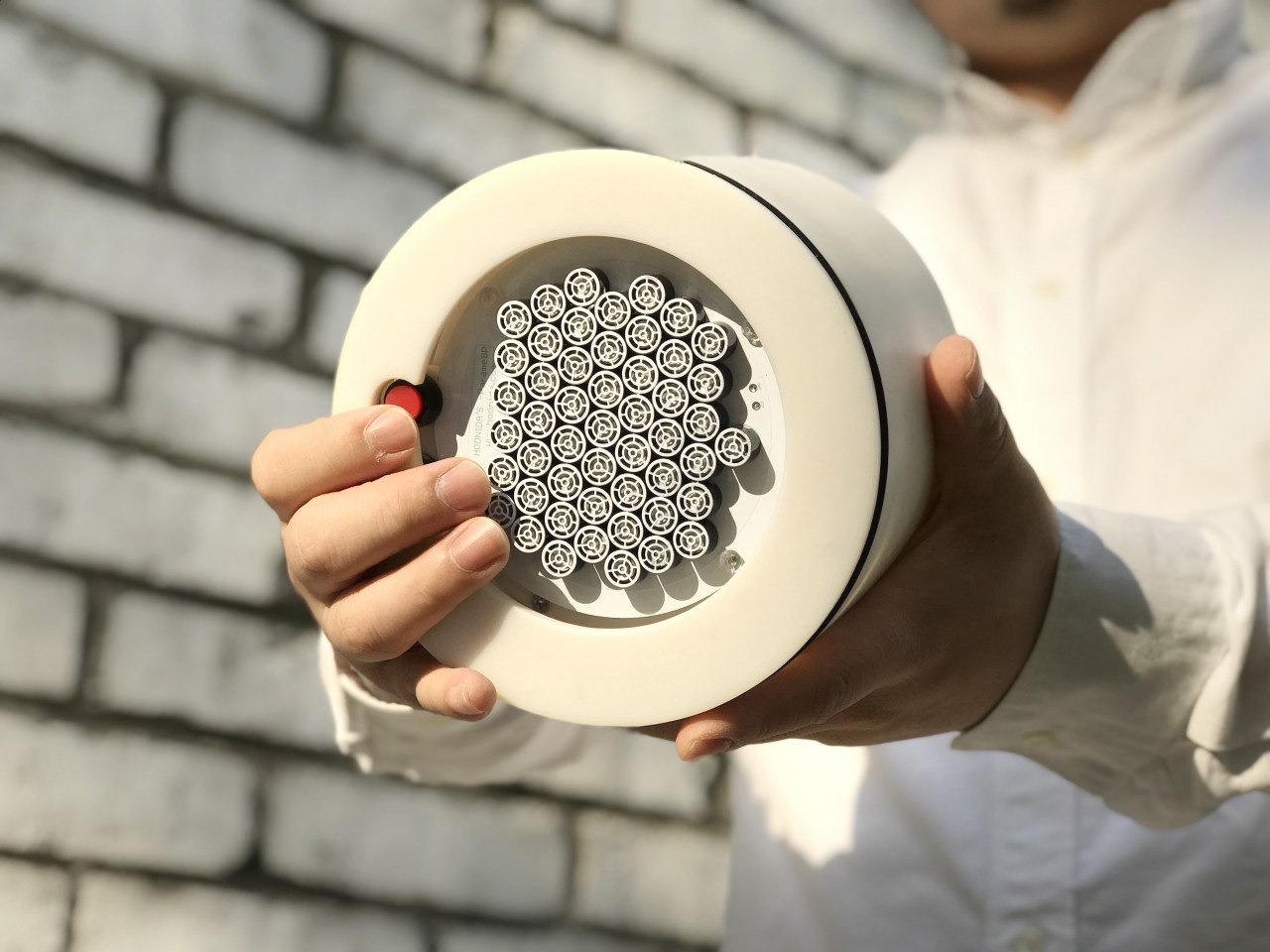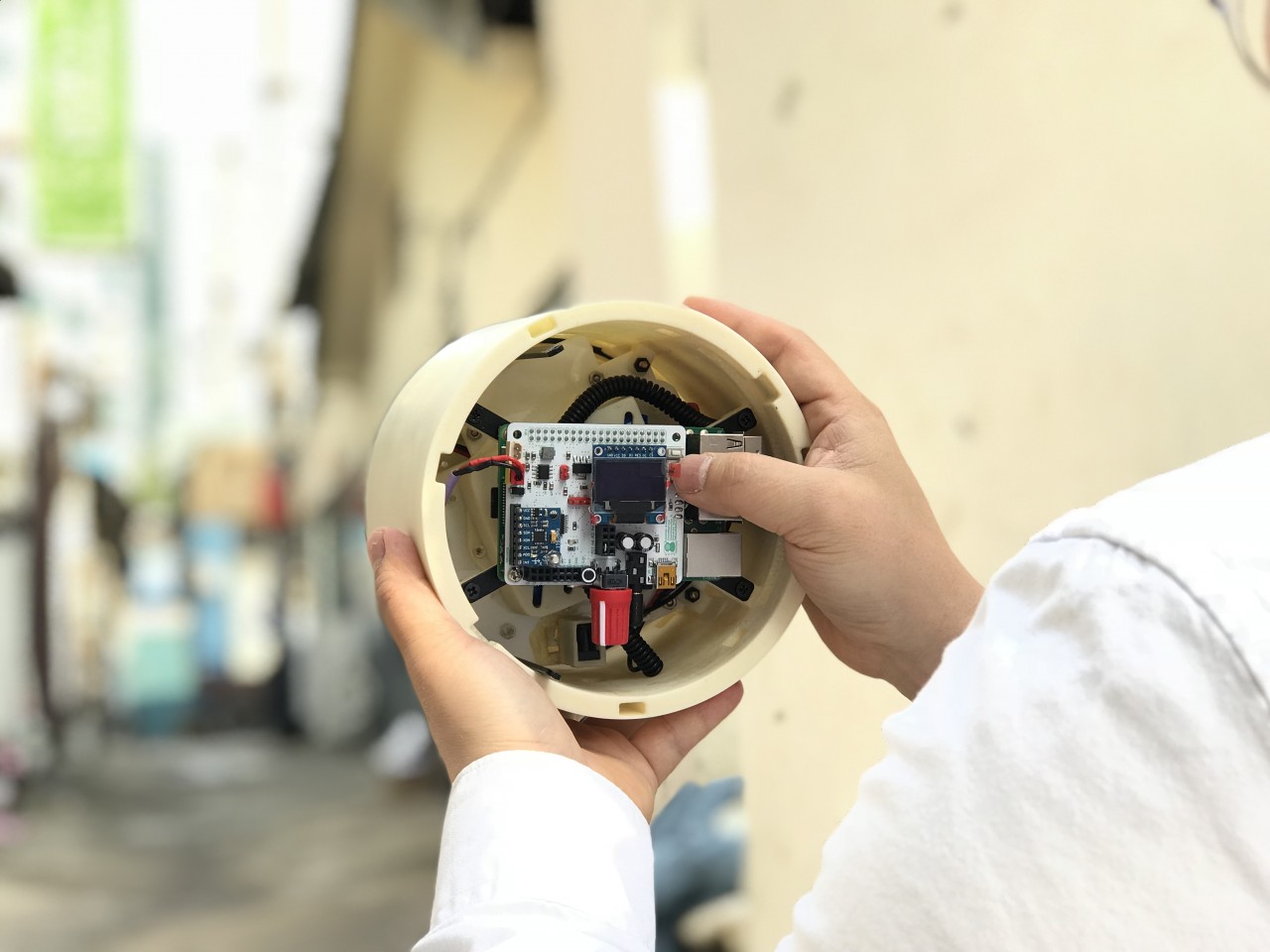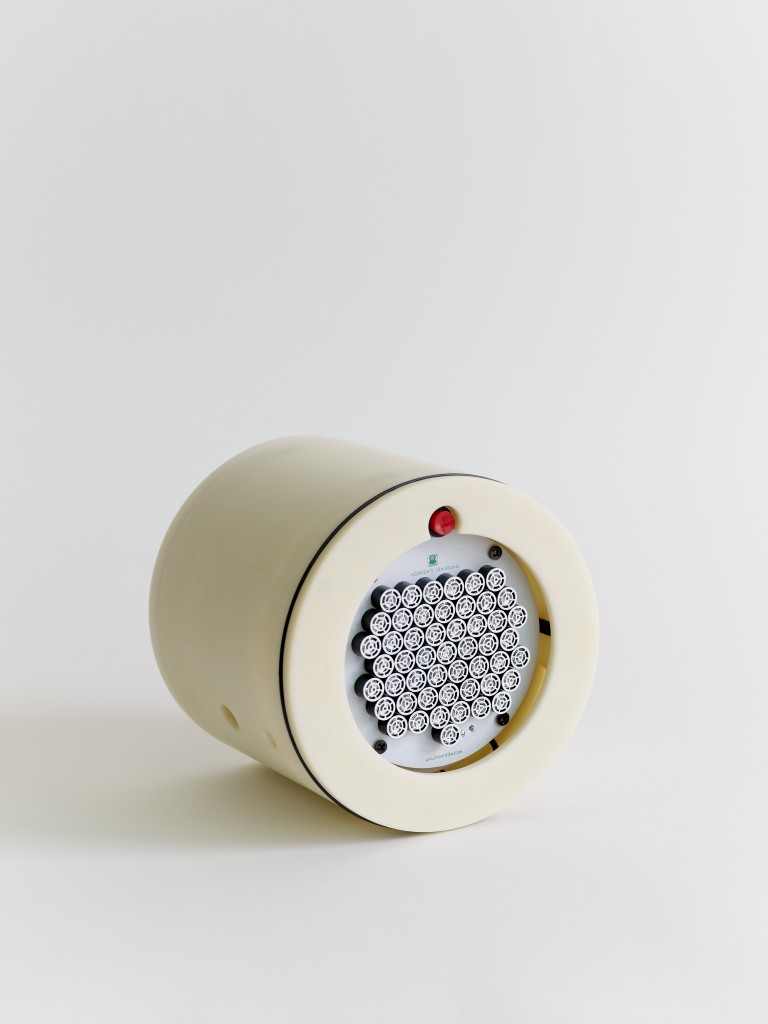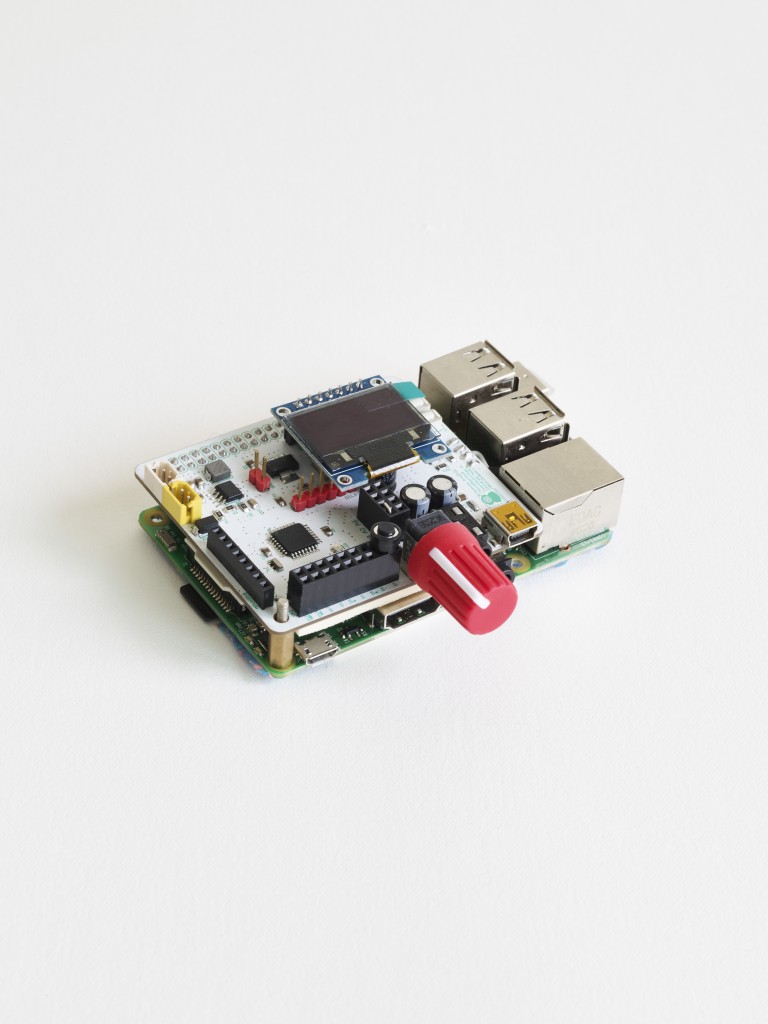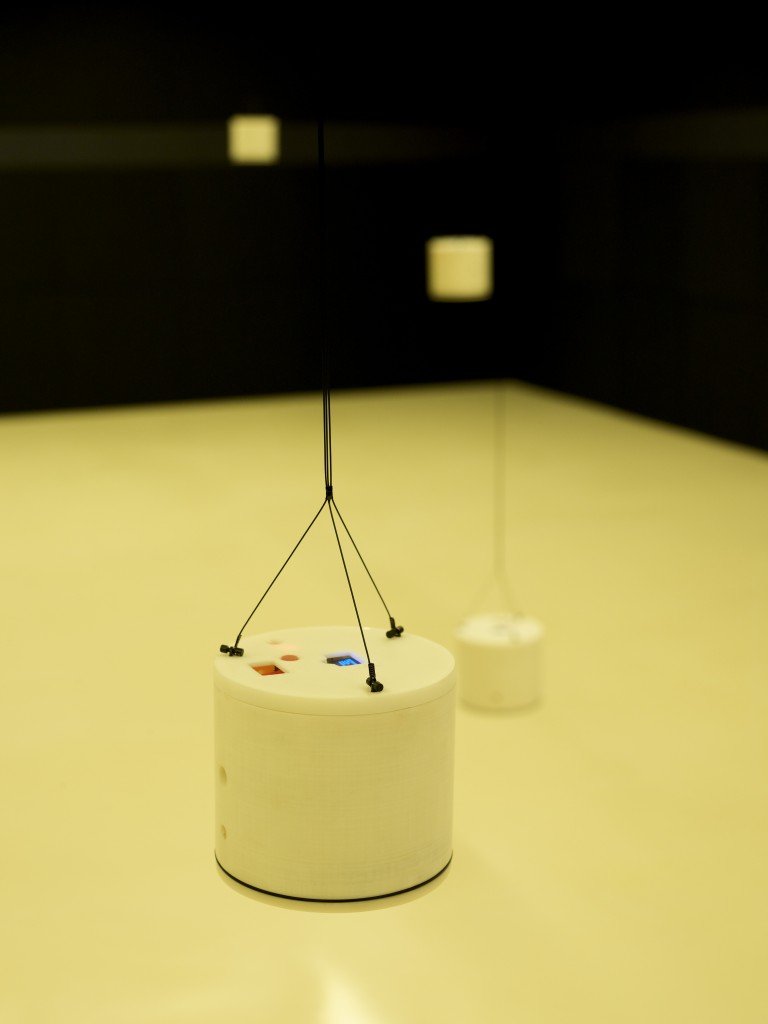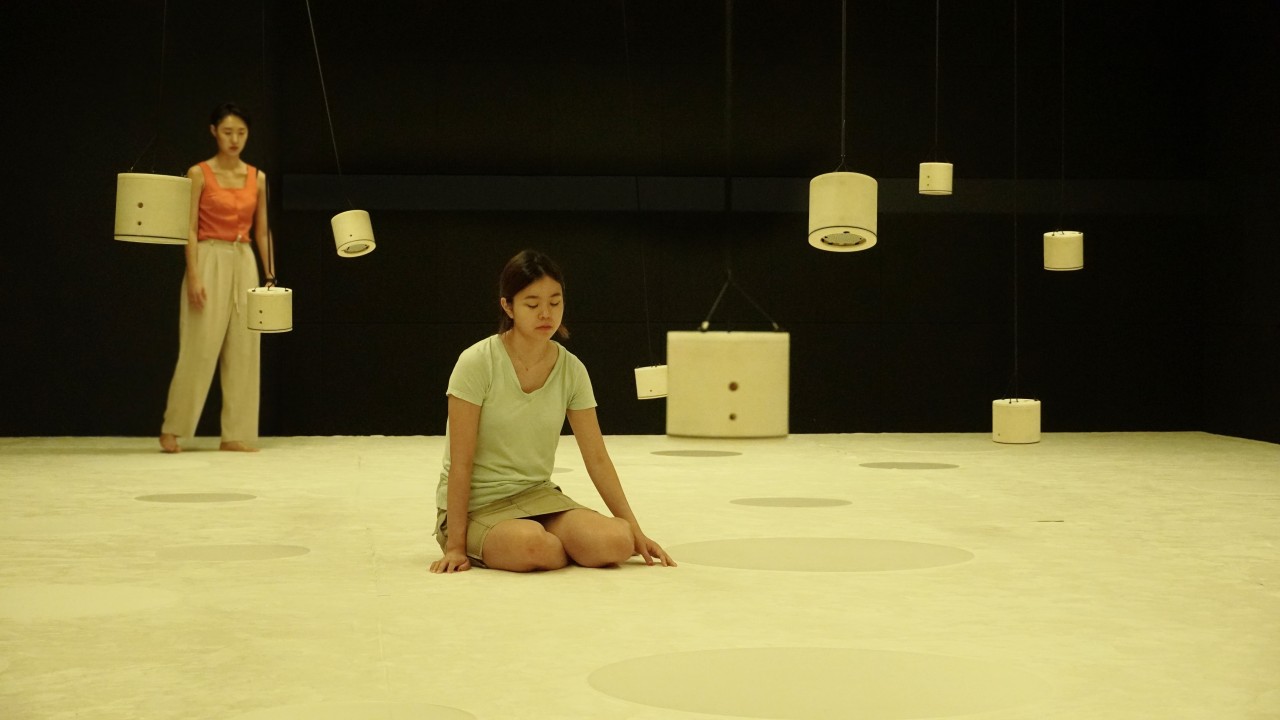Exhibitions
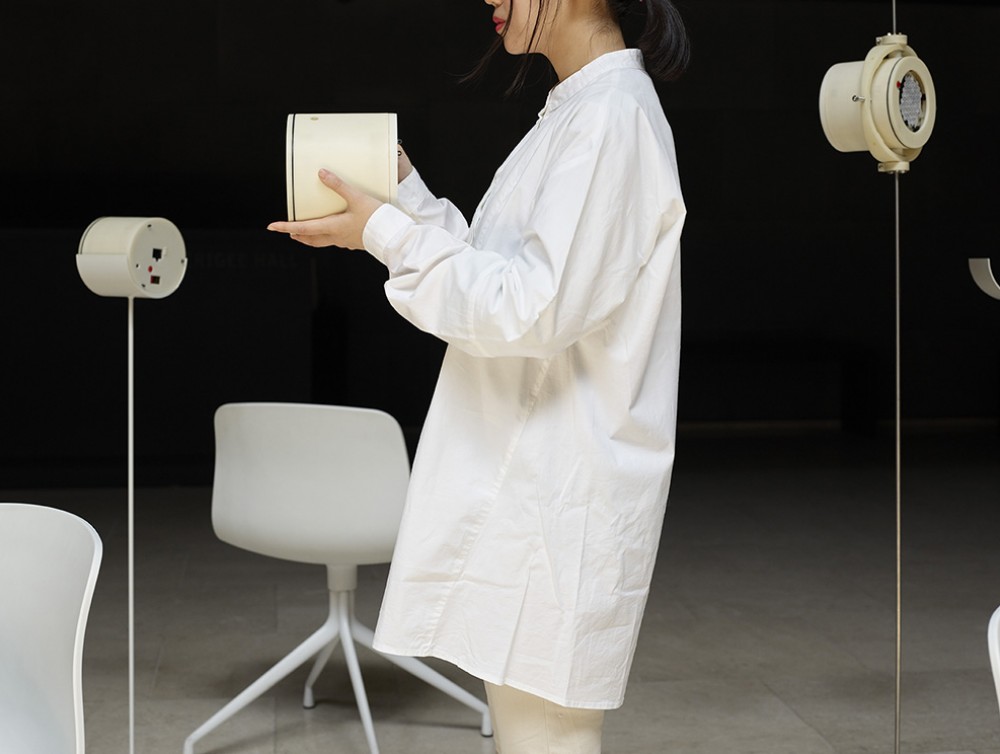
PERIGEE ARTIST #16 후니다 킴
익숙함이•쌓이고•녹아내리는 - 일상에 대한 낯선 번역
2018.06.08. FRI ~
2018.08.11. SAT
<거기에 있음을 넘어서서>
신승오(페리지갤러리 디렉터)
후니다 킴의 작업은 인간과 기계, 원본과 복사본, 시각과 청각, 공연과 인터랙티브, 실제와 재현에 대한 이야기들이 서로를 가로지르며 뒤섞여 있다. 그의 작업에서 중요한 요소 중 하나는 소리로 일반적으로 자신의 주변에서 듣게 되는 일상의 소리를 담아낸다. 또 다른 요소는 장치들이다. 소리를 담아낸다는 것은 어떤 물건 속에 있다는 말인데, 그가 소리를 사용하기 위해서는 녹음, 편집 그리고 다시 내보내기 위한 장치들이 필요하다. 그리고 마지막 요소는 이를 단순하게 들려주는 것이 아니라 퍼포먼스와 관객들이 직접 실행하는 인터랙티브적 전시로 나타나는 수행적 작업이라는 점이다. 그렇다면 이번 <익숙함이· 쌓이고· 녹아내리는-일상에 대한 낯선 번역> 전시에서는 이러한 것들이 어떻게 나타나는지 살펴보자.
위에서 언급한 세 가지의 요소들 중 먼저 다룰 것은 소리이다. 소리는 후니다 킴 작업의 시작점이자 그의 작업의 근간을 이루고 있다. 그가 관심을 가지고 접근하는 대상은 일상적인 소리로서의 배경음이다. 요즘은 도시에서건 시골에서건 모든 방향에서 소리가 날아들어 혼선 상태가 되며 아주 평범한 소리조차도 귀를 기울여 집중해야 들린다. 이렇게 우리의 청각은 여러 가지 소리들에 대해서 쉽게 무감각해져 버려서, 따로 훈련하지 않으면 많은 소리들을 구분해 낼 수도 없고, 느끼지도 못하는 것이 현실이다. 그런데 그는 우....
Beyond Being There
Seung Oh Shin (Perigee Gallery Director)
Hoonida Kim’s work displays trans-current narratives about man and machine, originals and copies, sight and hearing, performance and interactions, and reality and representation. One of the seminal elements of his work is the sound of mundane life he hears in his surroundings. Another factor is equipment. He need equipment to recording, editing, and let sound out. The last element does more than simply play sounds; it acts as a performative work or an interactive exhibition that involves viewers directly in the work. Let us examine how such elements are represented in the exhibition Familiarity•Cumulating•Running-Unfamiliar Translation of Everyday Life.
Among the three elements mentioned above, the first that we deal with is sound. Sound is the be-all and end-all of Kim’s work. He tackles background sounds as quotidian noise with interest. As sounds are nowadays being heard from all around — be they from an urban or rural area — we have to listen carefully to even very ordinary noises. Since our auditory sense tends to be insensitive to var....
신승오(페리지갤러리 디렉터)
후니다 킴의 작업은 인간과 기계, 원본과 복사본, 시각과 청각, 공연과 인터랙티브, 실제와 재현에 대한 이야기들이 서로를 가로지르며 뒤섞여 있다. 그의 작업에서 중요한 요소 중 하나는 소리로 일반적으로 자신의 주변에서 듣게 되는 일상의 소리를 담아낸다. 또 다른 요소는 장치들이다. 소리를 담아낸다는 것은 어떤 물건 속에 있다는 말인데, 그가 소리를 사용하기 위해서는 녹음, 편집 그리고 다시 내보내기 위한 장치들이 필요하다. 그리고 마지막 요소는 이를 단순하게 들려주는 것이 아니라 퍼포먼스와 관객들이 직접 실행하는 인터랙티브적 전시로 나타나는 수행적 작업이라는 점이다. 그렇다면 이번 <익숙함이· 쌓이고· 녹아내리는-일상에 대한 낯선 번역> 전시에서는 이러한 것들이 어떻게 나타나는지 살펴보자.
위에서 언급한 세 가지의 요소들 중 먼저 다룰 것은 소리이다. 소리는 후니다 킴 작업의 시작점이자 그의 작업의 근간을 이루고 있다. 그가 관심을 가지고 접근하는 대상은 일상적인 소리로서의 배경음이다. 요즘은 도시에서건 시골에서건 모든 방향에서 소리가 날아들어 혼선 상태가 되며 아주 평범한 소리조차도 귀를 기울여 집중해야 들린다. 이렇게 우리의 청각은 여러 가지 소리들에 대해서 쉽게 무감각해져 버려서, 따로 훈련하지 않으면 많은 소리들을 구분해 낼 수도 없고, 느끼지도 못하는 것이 현실이다. 그런데 그는 우리가 평소에 집중해서 듣지 않는 혹은 들리지 않는 모든 배경음(개 짖는 소리, 기차가 지나가는 소리 전화벨 소리 등등)을 소음 혹은 잡음이라고 지칭한다. 따라서 소음을 이용하는 작업은 그 용어의 사용에서부터 그가 우리의 관심에서 멀어진 것을 다시 중심에 옮겨놓기 위해 소리를 사용한다고 오인하게 만든다. 그렇지만 그는 소음이었던 것을 집중해서 들으면서 다시 어떤 소리로 인식하고 그것의 원래 존재를 파악하기 위해 원본에 충실하거나 원형을 충분히 살려내기 위한 녹음을 한 것이 아니다. 후니다 킴은 물리적 "진동"인 배경음이 인식되는 순간과 그것이 기계에 의해서 녹음되어 "수(數)"로 형질 변환되는 디지털 코드화에 관심을 가진다. 다시 말하면 그는 소리라는 데이터 채집을 통해 외형적으로 구분되지는 않지만 미세한 디테일의 재조합 가능성과 지금까지 듣지 못했던 방식으로 무엇인가 듣게 만드는 것을 연구한다. 따라서 그의 소음에는 움직임, 진동, 전류의 흐름 등이 담겨있어 원래라면 인식할 수 없는 소리도 감지할 수 있게 만든다. 그런데 이 디지털화된 소리는 자연의 소리를 담아내고 있지만, 그렇다고 그것을 복제한 것도 아니고 원래 소리의 원본도 아니다. 결국 작가가 주목하는 것은 디지털 매체를 통해 얻어지는 정보로 새롭게 가공되고 재창조될 수 있는 가능성을 가진 새로운 원본이라고 할 수 있다. 따라서 그의 작업에서 사용하는 소리는 청각적인 감각을 통한 일반적인 정보가 아니라 소리의 진동을 느끼는 촉각, 소리가 연상되게 만드는 시각, 그리고 이후에 살펴볼 장치 등을 통해서 공감각적인 대상으로 변환되는 것이다. 그리고 작가는 이를 통해 우리가 보편적으로 감각을 지각하는 방식의 전환을 유도한다.
다음으로 살펴볼 것은 그의 디지털 코드 매체 번역의 가장 기본적인 역할을 하는 <아파라투스apparatus>라는 소리 환경 장치이다. 이 장치는 그가 담아낸 소음을 다시 내보내는 역할을 한다. 이번 전시에서 사용하는 <아파라투스>는 초지향성 스피커를 사용하여 소리가 직선적으로 강력하게 나오지만 관객이 그 직선적인 범위에 들어오지 않으면 소리가 들리지 않는다. 그런데 이것들을 이리저리 흔들면, 내가 위치한 공간과 그 공간 안에서 반사되는 각도의 관계성에 의해서 갑자기 소리가 들리거나 사라지는 공감각적인 경험을 하게 된다. 또한 이 장치들은 음향 장치일 뿐만 아니라 이후에 살펴볼 퍼포먼스나 관객이 직접 작동할 수 있게 하는 인터랙티브적 전시에서 중요한 역할을 하는 오브제이기도 하다. 여기서 필자가 주목하는 것은 이 장치의 어원인데, 디바이스(Device)의 라틴어 어원인 아파라투스(Apparatus)는 기계, 장비 신체적 감각기관이라는 의미이다. 이렇게 작가가 또 다른 신체적 감각기관인 장치를 만들어 낸 것은 단순히 작가가 이야기하는 보이지 않는 물질성을 가지지 않은 소리로 공간을 채워내는 작업 그 이상의 의미가 있음을 추측하게 한다. 그러나 작가는 처음부터 그의 <아파라투스>를 오브제로서의 외형, 다시 말해 시각 기호적 의미로 해석되지 않길 바라왔다. 하지만 그는 이 장치를 만들어 낼 때 외형적인 형태뿐만 아니라 회로를 설계하고, 기계 속에 담겨 보이지도 않을 기판을 자신만의 독특한 방식으로 장치 자체를 철저하게 독창적인 것들로 만들어 낸다. 이런 것들로 미루어보아 그는 사실 기계가 이미 가지고 있는 시각적 구조 및 촉각적인 실체가 있는 감각적 특성들에 대해 관심이 있고, 이것이 사람들과 감각적으로 교류할 수 있는 가능성에 대해 본능적으로 반응하고 있는 것으로 보인다. 따라서 작가 자신도 자각하지 못한 사이에 <아파라투스>는 생물학적 신체와 기계적인 것들의 접촉(사람들의 내부도 <아파라투스>처럼 복잡하지만 내용물이 감추어져 있다)을 시도하면서 장치와 생물학적 연결을 통한 새로운 감각적 확장을 인지할 수 있는 지점들로 조금씩 이동하고 있다고 생각된다. 결국 그가 이런 장치들을 통해 시도하는 청각적 이미지의 구현은 외부의 이미지를 내부로 끌어들이는 것만이 아니라 다시 내부의 이미지를 외부로 내보내는 방식이며, 이런 장치와 신체 사이의 자연스러운 연결을 유발한다. 그러면서도 이러한 장치를 통해 재배열되는 인간의 신체적 감각과 이러한 감각들의 통합으로 채워지는 청각적 공간에는 고정된 초점이 없다. 결국 <아파라투스>는 특정한 관점으로 소리를 가둔 고정된 상태가 아니라 지속적으로 차원을 만들어 내는 디지털적인 매개체로서 우리와 접촉하면서 연결되는 오브제로서 중요한 역할을 한다.
마지막으로 퍼포먼스와 인터랙티브적인 요소들에 대해 살펴보자. 사실 전시기간 동안 정기적으로 공연하는 퍼포먼스를 본다면 쉽게 이해할 수 있지만, 그런 행위들이 없는 전시장에서 관객들은 공중에 가만히 매달려 있는 <아파라투스>들 때문에 당황스러울 것이다. 그러나 가만히 귀를 기울여보면 어떤 소리가 지속적으로 나고 있으며, 이 장치들을 건드리게 되면, 급작스럽게 소리는 전시공간을 비정형적으로 채워나간다. 물성을 가진 <아파라투스>는 사람의 행위를 필요로 하고 이런 접촉을 통해 발생하는 소리들은 관객에게 무형의 형태와 색을 가진 다층적인 감각으로 전환된다. 이런 일련의 과정들은 우리들이 자연스럽게 장치 자체의 자기 지시적인(이것을 움직이게 하는 행위를 촉발하는) 의미를 이해하게 만든다. 그것은 작가가 관객 스스로가 감각적 전이를 발생시키는 행위를 통해 자연스럽게 자신의 인식이 변환되어 가도록 유도한다. 이런 이유로 작가는 관객들이 전시장을 방문해서 같은 시간과 공간에서 동시에 존재하고 있는 공동의 주체로서 이들과 함께 전시된 오브제들을 움직이면서 새로운 감각적 토대를 쌓아 나가길 바란다. 이는 단순히 시각적으로만 보고 의미를 해석하고 이해하는 기존의 방식과 같이 실제 혹은 허구적 세계의 재현에 동참하길 원하는 것이 아니라 작품과 행위자 관객 사이의 특별한 관계 성립을 통해 직관적으로 받아들이고, 그것에 ‘나’를 직접 대면 시키기 위함이다. 따라서 그에게는 전시에서 어떤 것이 일어나고 있는 상황이 중요하지 명확하게 무엇이 일어나고 있는지 파악하는 것이 중요한 것이 아니다. 일반적인 우리가 어떤 것을 의식적으로 지각한다는 것은 '그것을 그 자체'로 지각하는 것이다. 이런 지각 이후에는 그 행위 안에서 의미가 조금씩 발생한다. 그러나 우리는 작가가 의도하는 장치를 움직이는 행위들을 통해 꼭 명확한 기호나 의미를 찾으려고 노력할 필요는 없다. 언어적인 표현은 결국 시각성을 담보로 한 것이므로 이는 작가에게는 중요하지 않으며, 오히려 위에서 살펴본 것처럼 <아파라투스>라는 오브제와의 접촉하는 바로 그 지점이 중요하기 때문이다. 그러나 실제적으로 이러한 행위들로 인해 관객들에게 어떤 것들을 불러일으킬지 예측하는 것은 불가능하다. 따라서 그는 다만 감각을 유발하여 어떤 상태로 변환되는 상황 속에서 각각의 주체들 스스로 그 이유를 발견할 수 있기를 바랄 뿐이다. 이와 같이 이번 전시는 무엇을 재현하거나, 하나의 사건으로서의 감각적 경험으로만 나타내기 위한 것이 아니라 그가 소리와 장치, 대상과 접촉하는 인터랙티브적 요소, 퍼포먼스를 통해 새로운 공감각적 환경 그 자체를 구현하고 있다. 이렇게 전시를 구성하는 요소들은 서로를 가로지르면서 기존의 물질성, 기표, 기의 모두가 상황에 따라서 분리되고 합쳐져 관객이라는 지각하는 주체가 가지고 있는 각자의 조건에 따라 다르게 변하는 고정되지 않는 의미들을 만들어 낸다. 여기서 중요한 점은 언어적인 시각적 표현에서 벗어나고자 하는 것이자, 재현의 단계를 넘어서고자 하는 것이며, 디지털 매체를 통한 새로운 감각들을 공유하는 것이다. 이렇게 전시의 의미들은 관객들이 개입되는 순간부터 그들 자신만의 법칙으로 독립적으로 형성된다. 그렇지만 개인들이 생산해내는 자신만의 그 어떤 것들은 명확하게 남겨지지 않고, 일시적인 것에서 머물 것이다. 따라서 후니다 킴의 전시는 지금 어떤 것과 접촉하는 행위의 현재라는 시간성이 중요하며, 이는 우리가 지금까지 시각적인 관점과 인식과는 다른 지점들을 발견할 수 있는 동기를 유발한다. 일반적으로 사람들의 행동에 결정적인 동기가 되는 것은 사실 조용한 성찰이나 신념들이라기보다는 감정이지만, 우리는 감각을 통한 비언어적인 의미들을 언제나 기계처럼 언어적으로 번역하게 된다. 하지만 작가는 장치와 접촉하여 연결되는 현재적 시간성을 통해 이러한 이성적 번역에 앞서 청각과 촉각을 통해 어떤 감정을 유발함으로써 새로운 디지털적 감각에 대한 것을 각자의 방식으로 인지하게 하는 계기를 마련한다.
지금까지 살펴본 것들을 정리하자면 인간은 물리적인 현존뿐만이 아니라 이성적, 지성적 현존으로 자기 자신을 인식하지만, 현재의 디지털적인 세상은 지금까지의 방식에서 새로운 변화를 가져오고 있다. 따라서 감각은 우리가 원하던 원치 않던 변해갈 수밖에 없다. 물론 아직은 이러한 것들이 명확하게 연결되어 드러나지 않는 것처럼 보인다. 이는 사람들이 지금까지 보편적으로 지속되어온 반복적인 삶으로 인해 무감각해져 있기 때문이기도 하다. 이런 상황에서 디지털은 항상 베타(Beta)이고, 완전히 체화(體化)되는 것은 불가능하지만, 인지하지 못하는 것에 대한 끊임없는 확장을 본성으로 가진 인간은 언젠가는 새로운 감각들을 원래부터 존재했던 것처럼 받아들일 것이다. 결국 후니다 킴이 그의 작업을 통해 이야기하고자 하는 것은 이러한 디지털적 환경 속에서의 인식의 전환일 것이다. 이는 전시의 제목처럼 우리에게 익숙한 것들이 쌓여서 어떤 것을 인지하게 되지만 결국 새로운 인식을 촉발하기 위해서는 이들이 녹아 내리는 과정이 필요한 것이며, 전시의 부제에서처럼 작가는 일상적인 소리를 바탕으로 아직은 낯선 것들을 보여줌으로써 이러한 과정들을 만들어 가는 중이다. 이번 전시는 관객들에게 디지털 세계에 맞춰 예민하게 반응하는 존재인지 아니면 기존의 틀을 아직은 넘어서지 못하는 존재인지 스스로 자문해 볼 수 있는 계기가 될 수 있을 것이다. 그러나 그 누가 그것을 분명히 할 수 있을 것이며, 어떻게 확실히 알 수 있을까? 이는 경계가 명확하지 않은 일이다. 그럼에도 불구하고 그 시작은 아마도 지금 우리가 있는 지점을 넘어서는 일이 될 것이며, 후니다 킴은 그 시작점으로서의 환경들을 만들어 내고 있는 것이다.
Seung Oh Shin (Perigee Gallery Director)
Hoonida Kim’s work displays trans-current narratives about man and machine, originals and copies, sight and hearing, performance and interactions, and reality and representation. One of the seminal elements of his work is the sound of mundane life he hears in his surroundings. Another factor is equipment. He need equipment to recording, editing, and let sound out. The last element does more than simply play sounds; it acts as a performative work or an interactive exhibition that involves viewers directly in the work. Let us examine how such elements are represented in the exhibition Familiarity•Cumulating•Running-Unfamiliar Translation of Everyday Life.
Among the three elements mentioned above, the first that we deal with is sound. Sound is the be-all and end-all of Kim’s work. He tackles background sounds as quotidian noise with interest. As sounds are nowadays being heard from all around — be they from an urban or rural area — we have to listen carefully to even very ordinary noises. Since our auditory sense tends to be insensitive to various sounds, we cannot distinguish or feel many of them without training. Kim refers to every background sound that is not heard and that we do not listen carefully to (i.e., a dog barking, the sound of a train, a telephone ringing) as noise. Thus, his works using sound mistakenly have us believe that he uses it so as to draw our attention to what we no longer pay heed to. However, he is not faithful to the original in terms of grasping its nature by listening carefully to a noise and he does not record it with the intent of reviving the original. Kim is interested in digital encoding at a time when background sounds, or physical vibrations are perceived and recorded by machines. In other words, he researches any possibility to recombine details by gathering sound data and things that enable us to hear something in a way we have never heard it before. As his noises include an element of movement, vibration, and the passage of an electric current, they enable us to sense even initially unperceivable sound. Even still, this digitized sound is neither a capture of natural sound, nor is it a copy or an original. He focuses on a new original that will be newly processed or recreated with data obtained through digital media. Thus, the sound he uses for his work is not general data secured through our aural sense but something conversed into a synesthetic object through the sense of touch as it feels the vibration of sound, the sense of sight suggestive of sound, and an apparatus to be reviewed afterwards. The artist leads us to have a shift in the way we normally perceive such sensuous things.
Next up for review is a sound environmental device called Apparatus that plays the most underlying role in translating digital code. This equipment works to transmit his noises. Since Apparatus is a kind of directional sound speaker, sound comes out straightforwardly but is not heard if the audience is not in its straightforward scope. If it is wavered from side to side, sound is suddenly heard due to the relationship of the reflected angles in the space and viewers are able to undergo a synesthetic experience. It is more than just an acoustic system as the objects play an important role in both the performance and the exhibition where viewers work interactively. What I focus on here is the etymology of Apparatus which had origin from Latin word Device, means refers to tools, machines, or physical sensory organs. His creation of another physical sensory organ or Apparatus has us guess that his work has meaning other than just filling a space with sound with no physical property. However, the artist initially wished his Apparatus not to be interpreted by only its visual sign or its outer appearance as an object. He has made it into something thoroughly ingenious by designing its circuit as well as its semblance in his own fashion. Judging from this, he seems to be interested in a device’s visual structure and its substantial, sensuous features, and reacts to sensuous exchanges with viewers instinctively. While even the artist didn’t notice, Apparatus is thought to have moved to a point where a new sensuous expansion through a biological link to a device is perceivable while making a foray into fusing a biological body into something mechanical (The interior of a human being is as complex as Apparatus but the contents are hidden). His realization of aural images using such devices is carried out not by drawing external images into the inside but bringing internal images to the outside, engendering a natural link between the equipment and the body. Yet there is no fixed focus on the human physical sense being rearranged through these devices and the auditory space filled by the integration of these senses. In the end, Apparatus manages to play an important role as a digital medium that constantly forges a new dimension as well as an object concerned with us through its contact.
Lastly, let us review the performance and interactive elements. When viewing a performance that takes place regularly, we can understand it with ease. However, viewers may be embarrassed when they see Apparatus in the gallery suspended in the air at a standstill with no action. If one pays attention to it, he or she realizes that a sound is being constantly made. If Apparatus is touched, the venue is abruptly and atypically filled with sound. Apparatus with some material property requires one’s action while the sound engendered by such contact is converted into a multilayered sense with intangible form and color. A series of such processes leads us to naturally understand Apparatus’ self-referent meaning (triggering an action to move it). This means that the artist leads viewers to naturally change their own perception through an act of engendering a sensuous transition. For this reason, the artist wishes viewers have laid a new sensuous foundation, moving such displayed objects as the common subjects who are in the same space and time at the venue. That is, his wish is not to take part in representing a realistic or fictitious world as in the preexisting way of seeing, interpreting, and understanding meaning, but to embrace it intuitively and face it directly through a very special relationship between the artwork and the viewer as a practitioner. Accordingly, important to him is not to grasp what happens apparently but to something happening itself. Perceiving something consciously means perceiving “something per se.” Since such a perception, meaning arises from an act in a piecemeal way. However, we do not need to strive to explore some specific meaning in his actions relating to how move his devices. Any linguistic expression is less important to the artist, since it is on security of visibility. As reviewed above, the contact point with the object of Apparatus is important. Similarly, it is almost impossible to predict what his actions invoke in viewers. Thus, he just hopes each subject is able to search for their own reason in a situation in which some provoked sense leads one to a certain state. As such, this exhibition is not to represent something only through a sensuous experience as an event, but to incarnate a new synesthetic environment itself through performative or interactive elements pertaining to sound, devices, or objects. The elements comprising the exhibition bring about unfixed connotations that morph depending on each subject’s condition as a member of the audience who perceives when preexisting material properties, the signifier, and the signified separate or join. The important point is to departing from any linguistic visual expression, overcoming the phase of representation, and sharing new sensations through digital media. The meaning of the exhibition is forged independently in its own manner the moment viewers are involved. However, that which each individual brings about remains either ambiguous or temporary. The temporality of the present in which viewers come across something is thus important in Kim’s exhibition. It has the motivation to discover another point different from preexisting viewpoints and perceptions. Although the crucial thing to people's behavior is usually emotional motive but not a quiet reflection or belief, we tend to translate even sensuous, non-linguistic meaning linguistically. All the same, the artist provides some opportunity to perceive something digital in their own manner by provoking an emotion prior to rationally translating it through the temporality of the present.
To sum up, a human perceives himself not only from his physical presence but from his rational, intellectual presence. However, a new change is brought up in the present digital world. Our senses cannot help but undergo change in this world, regardless of whether they are willing or not. Of course, they are apparently linked to one another so they seem to be unmasked. This is why they have become insensitive to this due to their commonly maintained daily routines. Under such circumstances, the digital is always considered second to none and it is impossible to be fully embodied. However, humans who have by instinct pursued a constant expansion toward an unperceived will embrace new sensations as something initially existent. What Kim intends to address in his work is a shift in perception in such a digital setting.
As its title suggests, we come to perceive something with familiarity but a new perception is triggered by the process of melting it. As its subtitle indicates, the artist has molded this process by displaying that which is unfamiliar based on quotidian sound. This exhibition will serve as an opportunity for the audience to ask themselves whether they are sensitive to the digital world or wedded to an established frame. That being said, who will be able to do this and how can we know it for certain? There is no clear line of demarcation. Even still, its start moves beyond where we presently stand. Hoonida Kim has been forging his own circumstances from this departure point.



